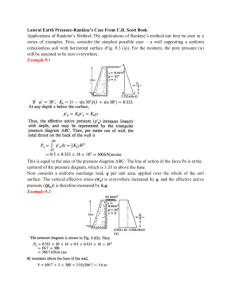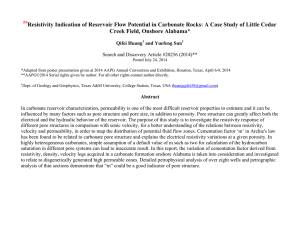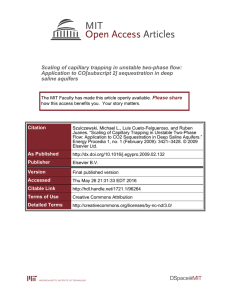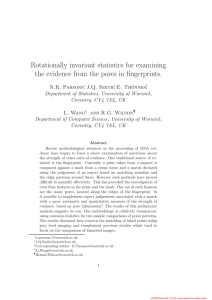Auxiliary material Calculation of the dynamic capillary pressure at wetting front
advertisement
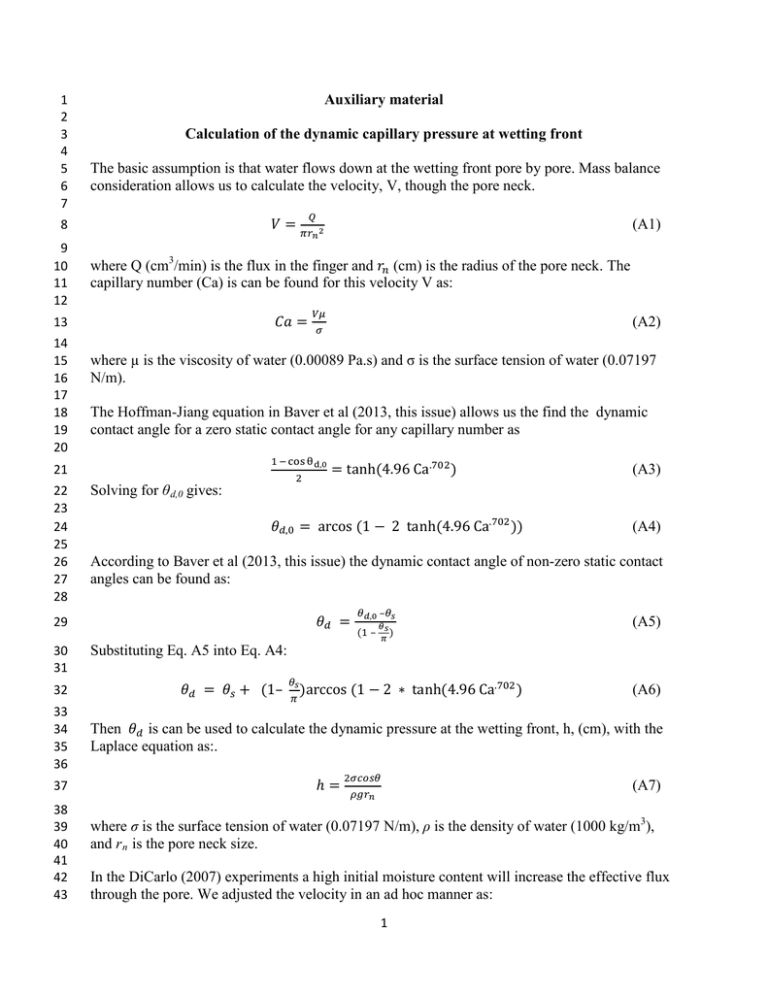
1 2 3 4 5 6 7 Auxiliary material Calculation of the dynamic capillary pressure at wetting front The basic assumption is that water flows down at the wetting front pore by pore. Mass balance consideration allows us to calculate the velocity, V, though the pore neck. 𝑄 𝑉 = 𝜋𝑟 8 9 10 11 12 𝑛 where Q (cm3/min) is the flux in the finger and 𝑟𝑛 (cm) is the radius of the pore neck. The capillary number (Ca) is can be found for this velocity V as: 𝐶𝑎 = 13 14 15 16 17 18 19 20 32 33 34 35 36 37 38 39 40 41 42 43 (A2) 𝜎 The Hoffman-Jiang equation in Baver et al (2013, this issue) allows us the find the dynamic contact angle for a zero static contact angle for any capillary number as Solving for θ d,0 gives: 1 − cos θd,0 = tanh(4.96 Ca.702 ) (A3) 𝜃𝑑,0 = arcos (1 − 2 tanh(4.96 Ca.702 )) (A4) 2 According to Baver et al (2013, this issue) the dynamic contact angle of non-zero static contact angles can be found as: 𝜃𝑑 = 29 30 31 𝑉𝜇 where µ is the viscosity of water (0.00089 Pa.s) and σ is the surface tension of water (0.07197 N/m). 21 22 23 24 25 26 27 28 (A1) 2 Substituting Eq. A5 into Eq. A4: 𝜃𝑑 = 𝜃𝑠 + (1– 𝜃𝑠 𝜋 𝜃𝑑,0 –𝜃𝑠 𝜃 (1 – 𝑠 ) (A5) 𝜋 )arccos (1 − 2 ∗ tanh(4.96 Ca.702 ) (A6) Then 𝜃𝑑 is can be used to calculate the dynamic pressure at the wetting front, h, (cm), with the Laplace equation as:. ℎ= 2𝜎𝑐𝑜𝑠𝜃 𝜌𝑔𝑟𝑛 (A7) where σ is the surface tension of water (0.07197 N/m), ρ is the density of water (1000 kg/m3), and r n is the pore neck size. In the DiCarlo (2007) experiments a high initial moisture content will increase the effective flux through the pore. We adjusted the velocity in an ad hoc manner as: 1 44 45 46 47 48 49 50 𝑉= 𝑚 𝑄�1+ 𝑖 � 𝑚𝑠 𝜋𝑟𝑛 2 where m i is the initial moisture content and m s is the saturated moisture content. 51 2 (A8) 52 53 Table A1: Finger properties for calculating fluxes in finger in Bauters et al (1998). percent of water repellent grains 0.0 3.1 5.0 5.7 9.0 54 55 velocity of fastest finger (cm/min), solved by slope, Fig 4` 0.58 1.94 2.59 2.87 5.24 finger width (cm) from Table 4` Calculated flux cm/min 45 2.1 2.8 2.7 3.5* 0.40 1.14 2.03 2.17 5.14 *Fingers split ` Fig 4 and Table 4 refer to Bauters et al. (1998) 3

